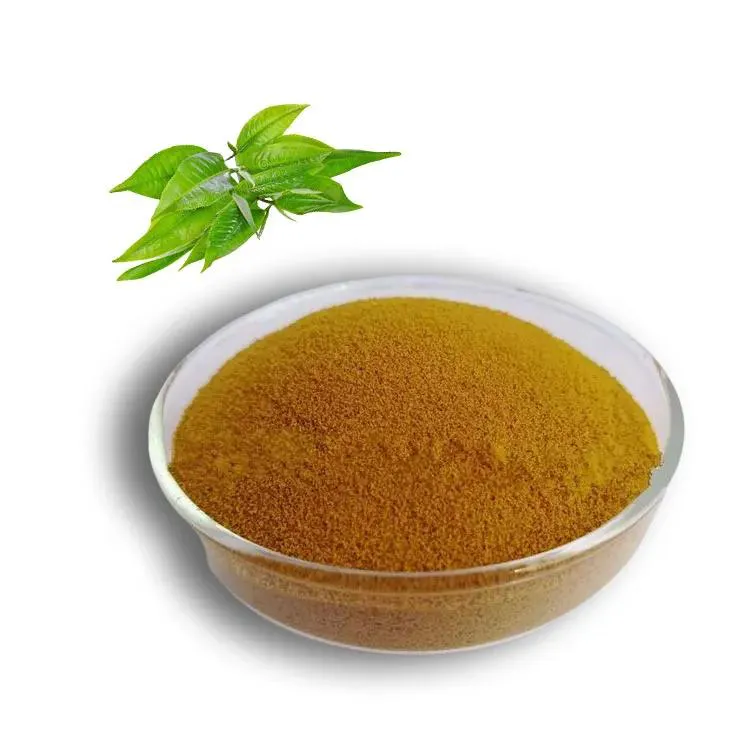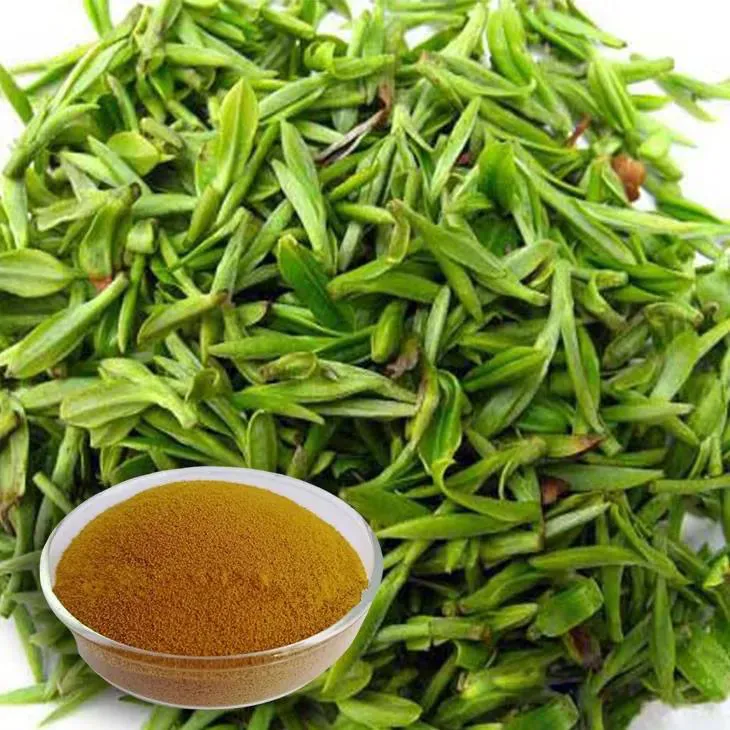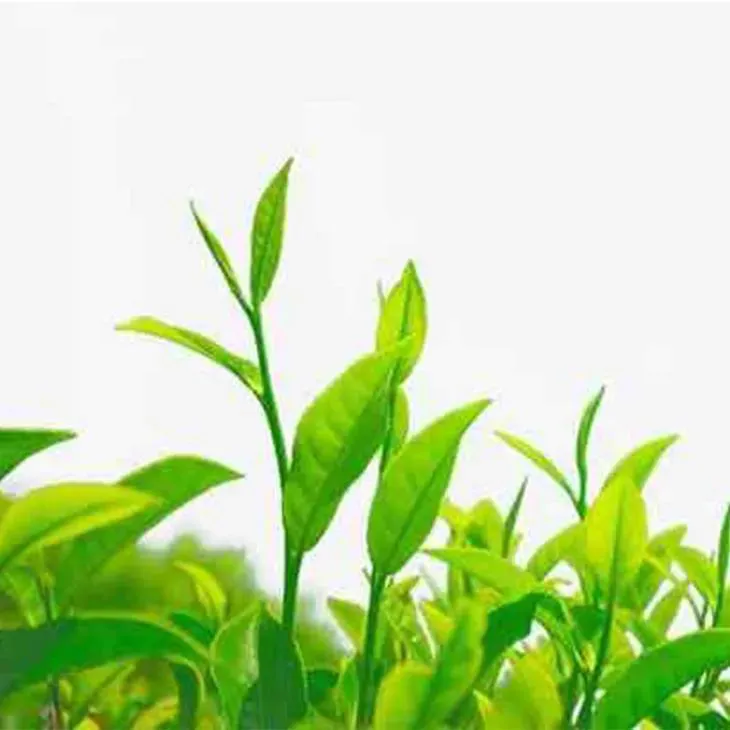- 0086-571-85302990
- sales@greenskybio.com
How to Extract Green Tea Extract by Steam Distillation.
2024-11-29

1. Introduction
Green tea is renowned for its numerous health benefits and has been used in various cultures for centuries. Extracting Green Tea Extract through steam distillation is an effective method to isolate its valuable components. This process can be used to obtain a concentrated form of Green Tea Extract that can be further utilized in health, cosmetics, and food industries.

2. The Steam Distillation Process
2.1 Preparation of Green Tea
Selection of Green Tea Leaves: The first step is to select high - quality green tea leaves. Fresh, young leaves are often preferred as they contain a higher concentration of the desired compounds. For example, the first flush of green tea leaves in spring are considered excellent for extraction due to their rich flavor and nutrient content.
Cleaning: Once the leaves are selected, they need to be thoroughly cleaned to remove any dirt, debris, or impurities. This can be done by gently rinsing the leaves in clean water and then allowing them to dry completely. It is crucial to ensure that the leaves are dry before proceeding to the next step to prevent any unwanted reactions during the distillation process.
2.2 Setting up the Steam Distillation Apparatus
Equipment Needed: A typical steam distillation apparatus consists of a distillation flask, a condenser, a receiving flask, and a heat source. The distillation flask should be large enough to hold the green tea leaves comfortably. The condenser is used to cool the vaporized compounds and convert them back into liquid form, and the receiving flask is where the extracted Green Tea Extract will be collected.
Assembly: Assemble the apparatus carefully, ensuring that all the connections are tight to prevent any leakage of steam. Place the green tea leaves in the distillation flask. Add a small amount of water to the distillation flask if necessary. The amount of water should be sufficient to generate steam but not so much that it dilutes the extract too much.
2.3 The Distillation Process
Heating: Start the heat source and gradually increase the temperature. As the water in the distillation flask heats up, it will turn into steam. The steam will pass through the green tea leaves, causing the volatile compounds in the leaves to vaporize. This process should be carried out at a controlled rate to ensure efficient extraction. Typically, a temperature range of 100 - 120°C is maintained during the distillation process.
Condensation: The vaporized compounds along with the steam will then move into the condenser. The condenser cools the vapor, causing it to condense back into liquid form. This liquid, which contains the green tea extract along with some water, will then drip into the receiving flask.
Duration: The distillation process usually takes several hours, depending on the amount of green tea leaves used and the efficiency of the apparatus. It is important to monitor the process regularly to ensure that the distillation is proceeding smoothly.
2.4 Post - distillation Processing
Separation of Extract and Water: Once the distillation is complete, the liquid in the receiving flask will be a mixture of green tea extract and water. To separate the extract from the water, techniques such as fractional distillation or solvent extraction can be used. Fractional distillation can further purify the extract by separating it based on the different boiling points of the components. Solvent extraction involves using a suitable solvent, such as ethyl acetate, to selectively dissolve the green tea extract and then separating the solvent from the extract through evaporation.
Concentration: After separating the extract from the water, the green tea extract can be concentrated to increase its potency. This can be done by using techniques like rotary evaporation, which removes the solvent or excess water under reduced pressure, leaving behind a more concentrated green tea extract.

3. Potential Challenges and Solutions
3.1 Incomplete Extraction
Problem: One of the common challenges in steam distillation of green tea extract is incomplete extraction. This may occur if the temperature is not high enough, the steam does not pass through the leaves evenly, or the distillation time is too short.
Solution: To address this issue, ensure that the temperature is maintained within the optimal range. Check the apparatus for any blockages or uneven steam distribution and correct them. Also, extend the distillation time if necessary, but be careful not to over - distill as it may lead to the degradation of some of the valuable compounds in the green tea extract.
3.2 Contamination
Problem: Contamination can occur from various sources during the extraction process. For example, if the green tea leaves are not properly cleaned, impurities may be carried over into the extract. Also, if the apparatus is not clean or there is a leakage in the system, external contaminants can enter the extract.
Solution: Thoroughly clean the green tea leaves before starting the extraction process. Ensure that the distillation apparatus is clean and sterilized before use. Regularly check for any leaks in the system during the distillation process and repair them immediately if found.
3.3 Degradation of Compounds
Problem: Some of the compounds in green tea are sensitive to heat and may degrade during the distillation process if the temperature is too high or the distillation time is too long.
Solution: Optimize the distillation temperature and time. Use a temperature - controlled heating source and closely monitor the distillation process. Additionally, consider using a shorter distillation time and then purifying the extract further using other techniques such as chromatography to separate the desired compounds from any degradation products.

4. Applications and Benefits of Green Tea Extract
4.1 In the Health Field
Antioxidant Properties: Green tea extract is rich in antioxidants such as catechins, which can help protect the body against oxidative stress. Oxidative stress is associated with various diseases, including cancer, heart disease, and neurodegenerative disorders. By consuming products containing green tea extract, individuals may reduce their risk of these diseases.
Metabolic Boost: It has been shown to have a positive impact on metabolism. Green tea extract can increase thermogenesis, which is the process by which the body burns calories to produce heat. This can potentially aid in weight management and may also improve insulin sensitivity, which is beneficial for individuals with diabetes or at risk of developing diabetes.
4.2 In the Cosmetics Industry
Skin Health: Green tea extract is often used in cosmetics due to its beneficial effects on skin health. It has anti - inflammatory properties, which can help soothe irritated skin. It can also protect the skin from UV damage, reduce the appearance of wrinkles, and improve overall skin complexion. Many skincare products, such as creams, lotions, and serums, contain green tea extract as a key ingredient.
Hair Care: In hair care products, green tea extract can promote hair growth and strengthen the hair follicles. It can also help prevent dandruff and improve the overall health of the hair.
4.3 In the Food Industry
Flavor Enhancement: Green tea extract can be used as a natural flavor enhancer in the food industry. It imparts a unique, refreshing flavor to food and beverages. For example, it can be added to ice creams, yogurts, and beverages like green tea - flavored drinks.
Preservative Properties: Some of the compounds in green tea extract have antimicrobial properties, which can help extend the shelf life of food products. This makes it a potential natural alternative to synthetic preservatives in certain food applications.
5. Conclusion
Steam distillation is a viable method for extracting green tea extract, which has a wide range of applications in health, cosmetics, and food industries. By understanding the process, potential challenges, and solutions, it is possible to obtain a high - quality green tea extract. The numerous benefits of green tea extract make it a valuable ingredient in various products, and as research continues, more applications and benefits are likely to be discovered.
FAQ:
Q1: What are the main materials needed for steam distillation to extract green tea extract?
For steam distillation to extract green tea extract, you will need high - quality green tea leaves as the primary material. Additionally, appropriate distillation equipment such as a distillation flask, condenser, and heating source are essential. You may also need some water for creating steam.
Q2: How do you prepare the green tea leaves before steam distillation?
Before steam distillation, the green tea leaves should be cleaned thoroughly to remove any dirt or impurities. Then, they are usually dried slightly to an appropriate moisture content. This helps in better extraction during the distillation process.
Q3: What are the potential challenges during the steam distillation process of green tea extract?
One potential challenge is over - heating, which may cause the degradation of some active compounds in the green tea. Another challenge could be incomplete extraction, if the steam does not reach all parts of the tea leaves effectively. Also, clogging of the distillation equipment due to tea particles can occur.
Q4: How can we overcome the problem of incomplete extraction during steam distillation?
To overcome incomplete extraction, make sure the tea leaves are evenly spread in the distillation flask. Also, adjust the steam flow rate appropriately. A slow and steady steam flow can ensure that the steam penetrates all parts of the tea leaves. Additionally, grinding the tea leaves to a proper size (not too fine to avoid clogging) can also improve extraction efficiency.
Q5: What are the applications of green tea extract in the health field?
In the health field, green tea extract is known for its antioxidant properties. It can help in fighting free radicals, which are associated with various diseases. It may also contribute to weight management as it can potentially increase metabolism. Moreover, some studies suggest that it has anti - inflammatory effects and can be beneficial for heart health.
Q6: How is green tea extract used in the cosmetics industry?
Green tea extract is widely used in the cosmetics industry. Its antioxidant properties help in protecting the skin from environmental damage, such as UV radiation. It can also be added to skincare products for its anti - inflammatory effects, which can soothe irritated skin. Additionally, it may have anti - aging properties as it can help in reducing wrinkles and improving skin elasticity.
Related literature
- Steam Distillation of Green Tea: A Comprehensive Study"
- "The Science behind Green Tea Extract and Its Extraction by Steam Distillation"
- "Applications of Green Tea Extract from Steam Distillation in Different Industries"
- ▶ Hesperidin
- ▶ citrus bioflavonoids
- ▶ plant extract
- ▶ lycopene
- ▶ Diosmin
- ▶ Grape seed extract
- ▶ Sea buckthorn Juice Powder
- ▶ Beetroot powder
- ▶ Hops Extract
- ▶ Artichoke Extract
- ▶ Reishi mushroom extract
- ▶ Astaxanthin
- ▶ Green Tea Extract
- ▶ Curcumin Extract
- ▶ Horse Chestnut Extract
- ▶ Other Problems
- ▶ Boswellia Serrata Extract
- ▶ Resveratrol Extract
- ▶ Marigold Extract
- ▶ Grape Leaf Extract
- ▶ blog3
- ▶ blog4
-
The best organic quercetin.
2024-11-29
-
Nature's Bounty Vitamin K2
2024-11-29
-
Chinese Saffron Extract Powder Factory.
2024-11-29
-
Cactus Extract Supplier
2024-11-29
-
Camu Camu Extract
2024-11-29
-
Golden Seal Extract
2024-11-29
-
Cocoa Extract
2024-11-29
-
Bitter Melon Extract
2024-11-29
-
Rose Hip Extract
2024-11-29
-
Buckthorn bark extract
2024-11-29
-
Fenugreek Extract Powder
2024-11-29
-
Boswellia Serrata Extract
2024-11-29
-
Troxerutin
2024-11-29
-
Uridine-5'-monophosphate Disodium salt
2024-11-29





















